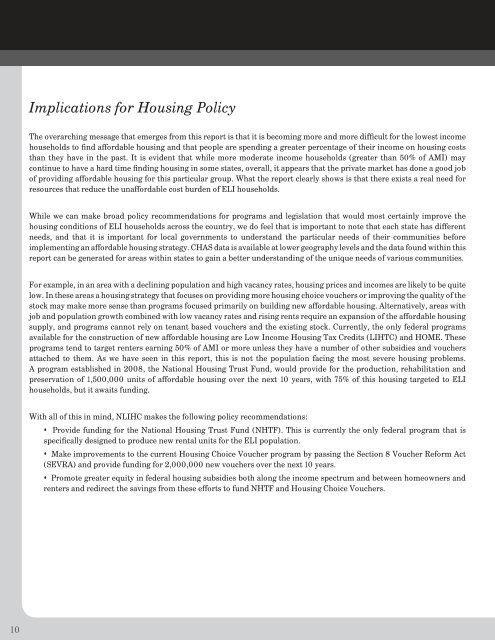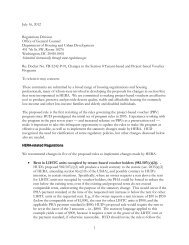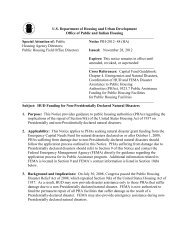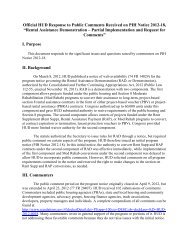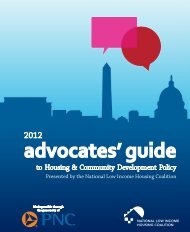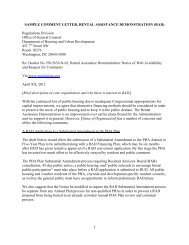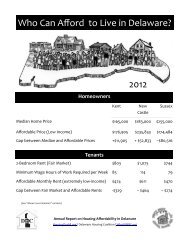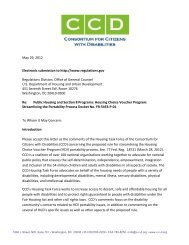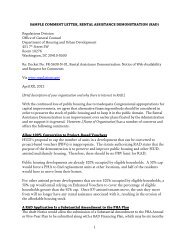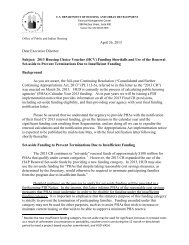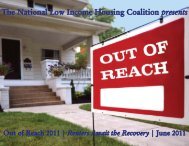Dark Before the Storm (.pdf, 131 KB) - National Low Income Housing ...
Dark Before the Storm (.pdf, 131 KB) - National Low Income Housing ...
Dark Before the Storm (.pdf, 131 KB) - National Low Income Housing ...
Create successful ePaper yourself
Turn your PDF publications into a flip-book with our unique Google optimized e-Paper software.
Implications for <strong>Housing</strong> Policy<br />
The overarching message that emerges from this report is that it is becoming more and more difficult for <strong>the</strong> lowest income<br />
households to find affordable housing and that people are spending a greater percentage of <strong>the</strong>ir income on housing costs<br />
than <strong>the</strong>y have in <strong>the</strong> past. It is evident that while more moderate income households (greater than 50% of AMI) may<br />
continue to have a hard time finding housing in some states, overall, it appears that <strong>the</strong> private market has done a good job<br />
of providing affordable housing for this particular group. What <strong>the</strong> report clearly shows is that <strong>the</strong>re exists a real need for<br />
resources that reduce <strong>the</strong> unaffordable cost burden of ELI households.<br />
While we can make broad policy recommendations for programs and legislation that would most certainly improve <strong>the</strong><br />
housing conditions of ELI households across <strong>the</strong> country, we do feel that is important to note that each state has different<br />
needs, and that it is important for local governments to understand <strong>the</strong> particular needs of <strong>the</strong>ir communities before<br />
implementing an affordable housing strategy. CHAS data is available at lower geography levels and <strong>the</strong> data found within this<br />
report can be generated for areas within states to gain a better understanding of <strong>the</strong> unique needs of various communities.<br />
For example, in an area with a declining population and high vacancy rates, housing prices and incomes are likely to be quite<br />
low. In <strong>the</strong>se areas a housing strategy that focuses on providing more housing choice vouchers or improving <strong>the</strong> quality of <strong>the</strong><br />
stock may make more sense than programs focused primarily on building new affordable housing. Alternatively, areas with<br />
job and population growth combined with low vacancy rates and rising rents require an expansion of <strong>the</strong> affordable housing<br />
supply, and programs cannot rely on tenant based vouchers and <strong>the</strong> existing stock. Currently, <strong>the</strong> only federal programs<br />
available for <strong>the</strong> construction of new affordable housing are <strong>Low</strong> <strong>Income</strong> <strong>Housing</strong> Tax Credits (LIHTC) and HOME. These<br />
programs tend to target renters earning 50% of AMI or more unless <strong>the</strong>y have a number of o<strong>the</strong>r subsidies and vouchers<br />
attached to <strong>the</strong>m. As we have seen in this report, this is not <strong>the</strong> population facing <strong>the</strong> most severe housing problems.<br />
A program established in 2008, <strong>the</strong> <strong>National</strong> <strong>Housing</strong> Trust Fund, would provide for <strong>the</strong> production, rehabilitation and<br />
preservation of 1,500,000 units of affordable housing over <strong>the</strong> next 10 years, with 75% of this housing targeted to ELI<br />
households, but it awaits funding.<br />
With all of this in mind, NLIHC makes <strong>the</strong> following policy recommendations:<br />
• Provide funding for <strong>the</strong> <strong>National</strong> <strong>Housing</strong> Trust Fund (NHTF). This is currently <strong>the</strong> only federal program that is<br />
specifically designed to produce new rental units for <strong>the</strong> ELI population.<br />
• Make improvements to <strong>the</strong> current <strong>Housing</strong> Choice Voucher program by passing <strong>the</strong> Section 8 Voucher Reform Act<br />
(SEVRA) and provide funding for 2,000,000 new vouchers over <strong>the</strong> next 10 years.<br />
• Promote greater equity in federal housing subsidies both along <strong>the</strong> income spectrum and between homeowners and<br />
renters and redirect <strong>the</strong> savings from <strong>the</strong>se efforts to fund NHTF and <strong>Housing</strong> Choice Vouchers.<br />
10


